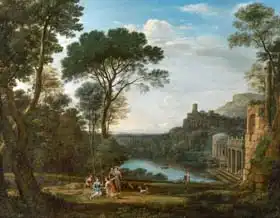About this finishing
Print. The image is printed on the top quality 10-ink HP Z9PS printer on HP matte 270 g / m2 paper. You can choose any size to an accuracy of 1 cm. A margin of 5 cm around the image is added to the size of the motif.


You can find a detailed description about our finishings
here.
Nymfa Egeria
Date:
1669Medium:
oil on boardLocation:
Museo e Gallerie Nazionali di Capodimonte, Naples, ItalyThe Nymph Egeria is another of
Lorraine's
series of paintings depicting scenes from Roman mythology. Similar to
Nymph and Satyr ,
Claude Lorrain primarily uses beautifully rendered landscapes, which are compositionally complemented by figures in the lower part of the picture. Here, too, we can admire ancient architecture, sophisticated trees and the water surface. According to legend, the nymph Egeria was the wife of one of the first kings of Rome, Numa. After his death, surrounded by grief, Egeria left the legendary city and, overcome by grief, was transformed into a spring. According to the myth, she thus became the goddess of springs and lakes.
Lorrain painted picture Nymfa Egeria in 1669. Prevailing color of this fine art print is dark and its shape is landscape. This art piece is located in Museo e Gallerie Nazionali di Capodimonte, Naples, Italy. This image is printed on demand - you can choose material, size and finishing.
Claude Lorrain (1600-1682). Family name Gelée. French landscape artist. He was the most important author of 17th century landscape paintings. He uncovered the beauty of different times of day - because of this, he painted landscapes with light from the west, east or in different weather conditions. Especially at the beginning, he enjoyed painting landscapes with distant views, distant horizons and elaborate details. In the more mature period of his life, he simplified his composition and tried to capture the atmosphere of the place. He painted pictures with tranquil views of the sea combined with monumental architecture (often ruins of ancient buildings - see his most famous painting
The Embarkation of the Queen of Sheba), landscapes and vast groves, all in a poetic and harmonic spirit. His painting techniques had many followers and lasted until the onset of
Impressionism.


